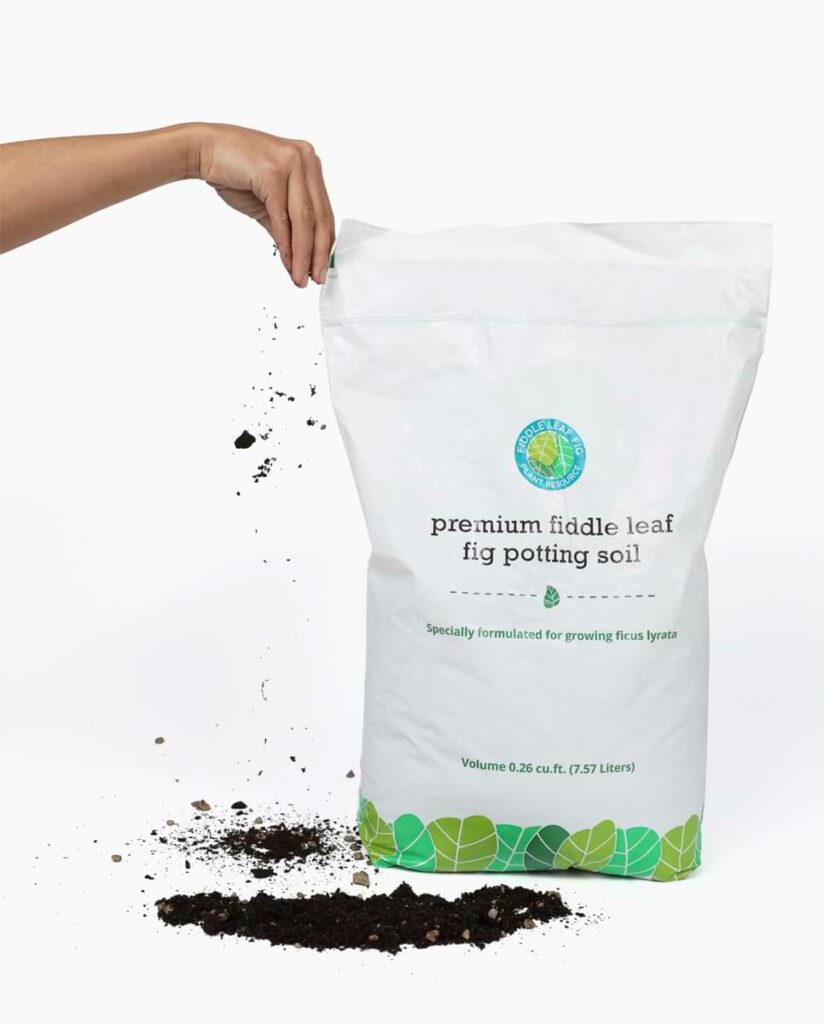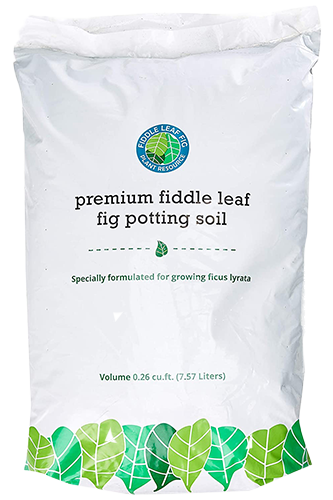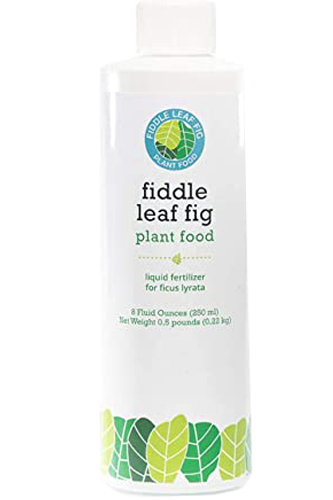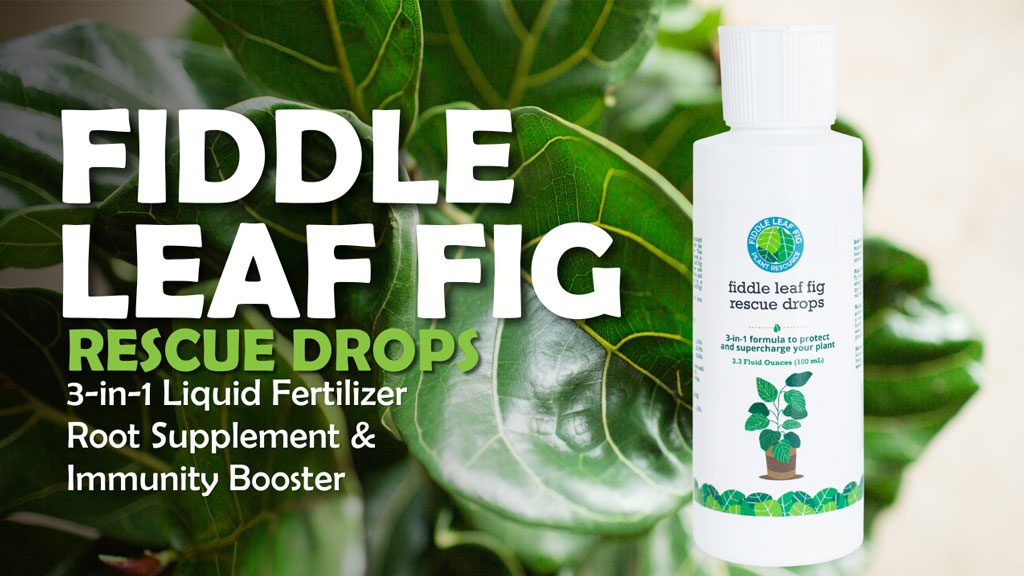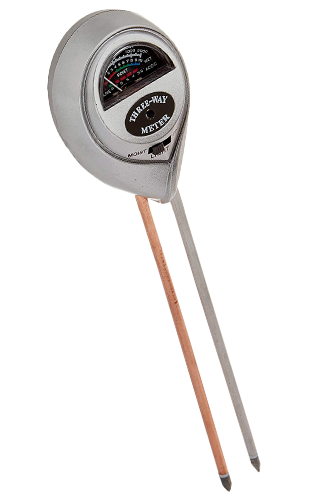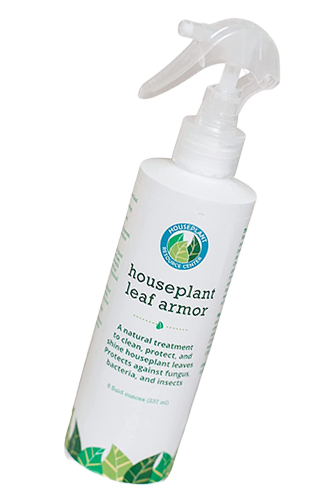Best potting soil for fiddle leaf figs:
One of the most important (and often overlooked) elements of raising a healthy fiddle leaf fig is choosing the best soil. After all, the soil is a major part of your fiddle leaf fig tree’s environment! That’s where the roots live and where your plant will absorb nutrients and a lot of moisture. It’s worth it to do your research to find the best potting soil mix for fiddle leaf figs so you can grow the healthiest and most beautiful plant possible!
Your soil choice can affect whether your watering routine will leave your fiddle over-, under-, or properly watered. The pH balance of your soil will affect how your fiddle’s roots absorb nutrients, which has a massive impact on the overall health of the tree.
While it’s tempting to bring home your new fiddle and pot it in any old potting mix you might have sitting around, it’s worth it to research what fiddle leaf fig trees actually need so you can provide the correct soil. This choice can make or break your experience as a fiddle leaf fig parent!
The ideal soil for fiddles should be a balance of drainage and water retention and should have the appropriate pH to ensure optimal nutrient uptake.
And, ideally, the best potting soil mix for fiddle leaf figs should contain the ideal nutrient balance to support your fiddle’s growth and health!
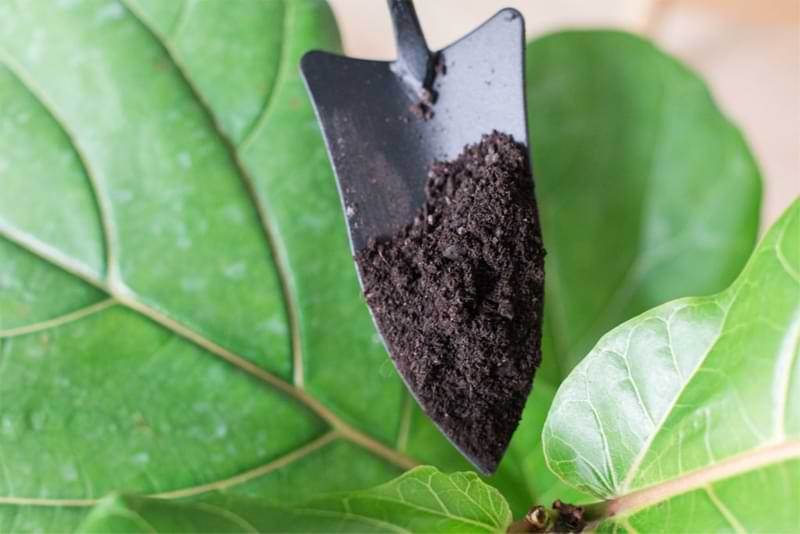
Do Fiddle Leaf Figs Need Special Soil?
While fiddle leaf figs can grow fairly well in different types of soil, the more closely you can replicate what allows them to thrive in the wild, the happier your fiddle will be!
In a pinch, you can pot a fiddle leaf fig in a nice, chunky cactus mix or throw some extra bark or perlite into an indoor potting soil to increase the drainage. This generally has the balance of drainage and water retention we’re looking for, but the pH may not be optimal for long-term health.
Also, there’s no guarantee that a general-purpose, premixed soil mix will have the right nutrient balance for a fiddle leaf fig. (Unless, of course, you purchase a mix made especially for fiddles. But we’ll get into that later!)
Fiddle Leaf Fig Potting Soil Mix Recipe
For a really serious houseplant parent, mixing your own potting soil is a useful skill! Plants need different ingredient compositions in their potting soil to thrive, and fiddle leaf figs are no different.
Here are some common ingredients you find in a lot of homemade potting mix recipes, and that can come in handy when mixing your own fiddle leaf fig potting mix. While it’s a lot of ingredients to purchase up front, these elements are very common in a variety of different potting mixes for different plant species. So if you have a lot of plants, you’ll get great use out of these!
Vermiculite
Vermiculite is a common ingredient in houseplant potting mixes.
Vermiculite is a hydrated silicate mineral that is heated until it expands and forms a shape similar to a tiny accordion, made up of layers and layers of thin plates. It’s an indispensable ingredient in potting mixes because it is sterile, nontoxic, and long-lasting, so it will not mold or break down in the soil.
Vermiculite is amazing for improving overall soil structure, as it increases aeration while also increasing water retention without making the soil soggy. This amazing substance prevents soil from becoming compacted, and also absorbs water and then releases it at a rate ideal for many plants’ water needs.
It also has a pH of about 7, which is neutral and ideal for fiddle leaf figs.
Vermiculite has lots of uses in gardening beyond soil conditioning, so it’s definitely something to keep around if you plan to grow a lot of plants!
Perlite
Perlite is essentially pumice, a naturally occurring volcanic glass that has been heated to temperatures exceeding 1,600 degrees Fahrenheit, which causes it to “pop” and expand into a light, porous material. Perlite is used much like vermiculite to aerate soils, though it’s much more common. If you’ve ever bought a pre-mixed potting soil from a gardening store, you probably noticed little white pebbles mixed in with the organic material. That’s perlite!
Perlite is a common and inexpensive ingredient for homemade potting mixes, and it’s great for mixing into pre-made potting mixes to increase the aeration. (Because, we get it, you don’t always have the time or desire to make a potting mix from scratch!)
If you plan to make your own potting soils, make sure to keep a bag of this around at all times!
Grit
Grit refers to crushed rock or sand that gardeners use to improve soil structure. While this sounds like a very simple material, gardening or horticultural grit is actually carefully sifted through a screen to ensure that the particles are the correct size (2-4 mm) for maximum benefit for the overall composition of your potting mix.
Grit is perfect for loosening up dense soil, preventing clumping or compacting, and has a neutral pH, which makes it ideal for mixing with organic material for a highly nutritious and well-aerated potting mix.
Additionally, grit is more affordable than vermiculite or even perlite. It’s also very easy to find!
Organic Material
So far we’ve discussed several inorganic materials you might find in potting mixes or mix into your fiddle leaf fig potting mix. But the organic material is just as important because it provides base for your soil structure and the nutrients for your fiddle leaf fig to grow!
Organic material refers to any plant or animal material that breaks down into a rich material from which plants absorb nutrients.
When shopping for organic material for your homemade potting soil, you’ll find a variety of different materials to mix and match, including different manures, coco coir, worm castings, and compost. Each of these materials is nutrient-rich and carries a different pH that makes them appropriate for different plants.
Organic material is also important for allowing the soil to retain the right amount of moisture, whereas inorganic materials like perlite and grit typically improve drainage and aeration. Both are important, and both are necessary for a well-balanced potting mix.
Finally, these materials foster a healthy ecosystem of beneficial microorganisms and even insects in the soil while at the same time reducing the risk of diseases caused by harmful microorganisms and bacteria.
The crucial importance of organic material can’t be overstated.
Watch to learn more about Premium Fiddle Leaf Fig Soil
Ready-Mixed Potting Soil
Do you find this all overwhelming? That’s okay, we don’t blame you! Crafting homemade potting mixes can be tricky, and sometimes you just don’t want to buy a bunch of different ingredients that you’ll have to store for a long period of time.
If you’re looking for a pre-mixed potting soil for fiddle leaf figs that’s ready to go straight out of the bag, our Premium Fiddle Leaf Fig Potting Soil is the perfect choice!
This nutrient-rich blend of coco coir, perlite, and aged bark is the perfect balance of drainage and water retention for fiddle leaf fig trees and has the ideal pH for ficuses. (In fact, you can also use this soil for all species of ficus and aroids!)

Fiddle Leaf Fig Soil pH
Fiddle leaf fig trees thrive best in a soil pH of 6-7, which is neutral to slightly alkaline. When composing a fiddle leaf potting soil, it’s best to use ingredients with a similar pH.
Soil pH is often overlooked, but it can affect the plant’s ability to absorb nutrients from the soil. This can show up as yellowing leaves and can eventually kill your plant!
Soil pH can also change over time, so it’s helpful to measure the pH of your soil every once in a while. We highly recommend this 3-in-1 moisture meter to keep tabs on the moisture and pH levels of your soil as well as light conditions in your fiddle leaf fig’s environment. This one tool can eliminate a lot of guesswork and help you create the perfect conditions for your tree.
Repotting Fiddle Leaf Fig
Once you have bought or made your ideal fiddle leaf fig potting soil, it’s time to actually repot your fiddle leaf fig into that soil.
Luckily, this is quite easy to do!
First, unpot your fiddle by tipping it on its side and gently coaxing it out of the pot. If it’s a plastic grower’s pot, you can squeeze the pot a little to get the root ball out. You can also use a trowel or even a butter knife to run around the inside of the pot to loosen things up if necessary.
Once you have removed your fiddle from its original pot, massage the root ball to remove as much of the old soil as possible.
Then place a few inches of your new soil in the bottom of a clean pot. This can be a brand-new pot, or you can clean and sanitize the old one. Make sure your pot has drainage holes!
Place your tree upright in the pot and fill in the sides with your new potting mix, leaving about two inches of headroom at the top for watering.
Once your tree is in its new pot, water thoroughly and add a little more potting mix to the top to compensate for settling.
That’s it! Repotting itself is quite easy, but some fiddle leaf fig owners find the week or so following to be challenging. Here’s why.
Root Shock
When a fiddle leaf fig experiences a major change in its environment—like a move or being repotted—it can experience root shock, which can lead to a week or so of droopy or even dropped leaves.
Many fiddle leaf fig owners panic at this point and start making even more changes to try to mitigate the effects of root shock, but this is actually the WORST thing you can do right now.
Fiddles thrive on consistency, so after you repot your plant, place it in a spot where it will get lots of bright, indirect sunlight and then leave it alone. Don’t repot it again. Don’t keep watering. And definitely don’t fertilize for at least a month after repotting.
Just make sure your tree has plenty of light, and then give it space. It will recover within a week or two and be back to its beautiful, perky self!
Root Rot
Fiddle leaf fig owners generally live in fear of root rot because fiddles are generally prone to this disease and can quickly die once root rot sets in, if it isn’t treated quickly.
This is one of the biggest reasons why soil aeration and drainage is so critical! If your fiddle’s roots sit in water for too long, they can start to rot.
If you do notice signs of root rot (usually mushy stems or dark-brown spots on the lower leaves), repot your plant into a fresh, fast-draining soil and ease up on the water for a little while. When you do water, use our Root Rot Treatment to help the roots recover.
FAQ Can you use cactus soil for fiddle leaf figs?
This is a common question! In general, cactus soils drain quickly and can work quite well for a fiddle leaf fig, but the nutrient content isn’t always appropriate for a ficus. If you choose to pot your fiddle in cactus mix, make sure to start fertilizing regularly with Fiddle Leaf Fig Food about a month after repotting your plant.
FAQ Can I use orchid potting mix for fiddle leaf figs?
While orchid mix typically drains well, which is good for a fiddle, most orchid potting mixes have a pH of 5.5-6.5, which can be a little too alkaline for a fiddle. If your orchid mix is closer to that 6.5 mark, your fiddle might do very well in it! (Here’s another situation in which a pH meter can come in handy!)
Your Fiddle Leaf Fig Deserves the Best!
Never underestimate the importance of the best potting soil mix for fiddle leaf figs. Your potting soil choice can affect the short-term and long-term health of your fiddle, so choose wisely!
Resources:

